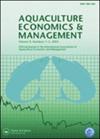Profitability differences between public and private firms: The case of Norwegian salmon aquaculture
IF 3.8
2区 经济学
Q1 AGRICULTURAL ECONOMICS & POLICY
引用次数: 15
Abstract
Abstract Capital requirements increase as aquaculture becomes more industrialized, with firms increasing their scale of production and capital intensity. Public listing at stock exchanges can provide improved access and cheaper financing for firms. Since the public listing is a fairly recent phenomenon and relatively few aquaculture firms have entered stock markets, it is useful to investigate the differences in profitability among listed and private aquaculture firms. Our econometric estimates based on a unique panel dataset of Norwegian salmon companies indicate that the sources of profitability, as measured by return on assets (ROA), are different among the two groups of companies. Listed companies are able to increase profitability through working capital optimization; however, they are more negatively affected by operating leverage and liquidity. This indicates that using liquidity as a risk reduction measure is costly in the industry. Although private firms have historically performed better on average in terms of ROA, the difference is not statistically different.公共和私营企业盈利能力的差异:以挪威三文鱼养殖为例
摘要随着水产养殖产业化程度的提高,企业的生产规模和资本强度也在增加,资本需求也在增加。在证券交易所公开上市可以为公司提供更好的融资渠道和更便宜的融资。由于公开上市是最近才出现的现象,而且进入股市的水产养殖公司相对较少,因此调查上市和私营水产养殖公司的盈利能力差异是有用的。我们基于挪威三文鱼公司独特的面板数据集进行的计量经济学估计表明,以资产回报率(ROA)衡量的盈利来源在两组公司之间有所不同。上市公司能够通过优化营运资金来提高盈利能力;然而,它们受到运营杠杆和流动性的负面影响更大。这表明,使用流动性作为降低风险的措施在行业中成本高昂。尽管私营企业在ROA方面的平均表现历来较好,但这一差异在统计上没有什么不同。
本文章由计算机程序翻译,如有差异,请以英文原文为准。
求助全文
约1分钟内获得全文
求助全文
来源期刊

Aquaculture Economics & Management
FISHERIES-
CiteScore
7.30
自引率
17.90%
发文量
21
期刊介绍:
Aquaculture Economics and Management is a peer-reviewed, international journal which aims to encourage the application of economic analysis to the management, modeling, and planning of aquaculture in public and private sectors. The journal publishes original, high quality papers related to all aspects of aquaculture economics and management including aquaculture production and farm management, innovation and technology adoption, processing and distribution, marketing, consumer behavior and pricing, international trade, policy analysis, and the role of aquaculture in food security, livelihoods, and environmental management. Papers are peer reviewed and evaluated for their scientific merits and contributions.
 求助内容:
求助内容: 应助结果提醒方式:
应助结果提醒方式:


